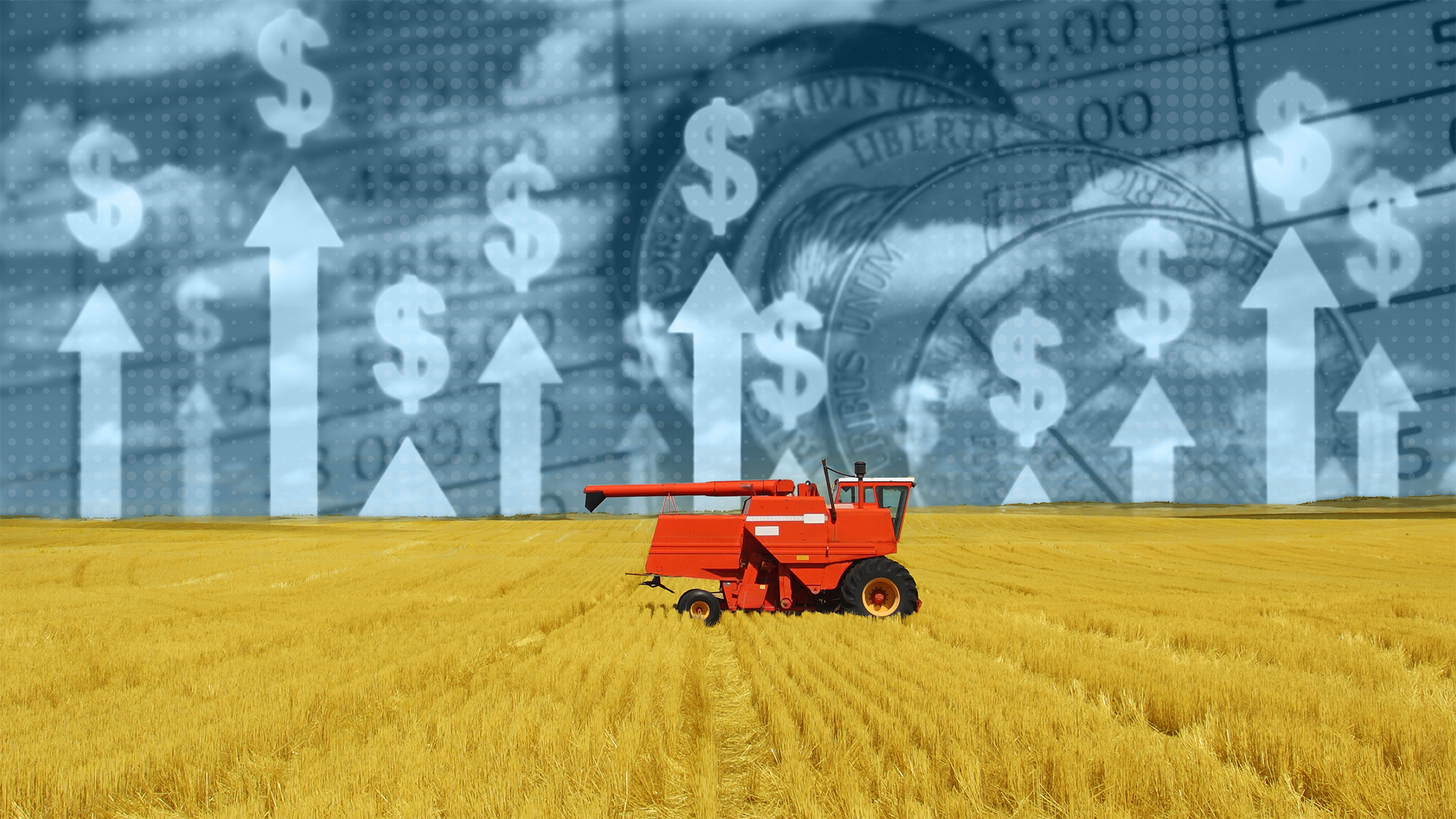Even as input cost pressures continued to ramp up, strong commodity prices benefited agricultural producers, according to a recent Federal Reserve Bank of Minneapolis survey. “Producers should have stable to increasing gross farm income in 2022,” said a South Dakota banker. “However, in 2023, I anticipate substantial increase in all farm operating expenses.”
That was one of multiple comments on the Minneapolis Fed’s second-quarter agricultural credit conditions survey highlighting concern about soaring input costs amid growing revenues. The survey, conducted during July, indicated farm incomes increased from April through June relative to a year earlier. Spending on capital equipment and farm household purchases also increased. Growing incomes led to reduced loan demand and supported a high rate of loan repayment, while renewals and extensions mostly held steady. Farmland values rose further, while cash rents also increased.
The outlook for the third quarter was more positive, despite some gloomy sentiment about inflation and the overall economy.
Farm income, household spending, and capital investment
Farm incomes and spending increased on the strength of crop and livestock prices. Four in 5 district lenders surveyed reported that farm incomes increased in the second quarter of 2022 compared with the same period in 2021. Farm household spending also increased. More than a third of respondents said capital spending by farming operations was up, though half of lenders reported that it was stable.
Demand for loans, required collateral, and interest rates
Demand for credit fell further in the second quarter, as a result of growing incomes. Almost half of respondents indicated that loan demand decreased relative to a year earlier, compared with 16 percent who reported greater demand. Collateral requirements were unchanged according to a great majority of lenders surveyed: 96 percent. Increasing interest rates were another spiking input cost for farmers and ranchers. Average fixed and variable rates on operating, machinery, and real estate loans all increased substantially in the second quarter after a moderate increase in the previous quarter.
Loan repayments and renewals
“The renewal season was probably the easiest one in my 30 years in banking,” commented a South Dakota lender. Loan renewals largely held steady or decreased across the district, while the rate of repayment on agricultural loans increased, reflecting continued improvement in farm finances. More than 70 percent of lenders stated that the number of renewals was unchanged, with an additional 20 percent reporting that renewals were down. Half of respondents reported that loan repayments were up from a year earlier, while only 2 percent said that repayment rates decreased. No banks reported having refused a loan due to a shortage of funds.
Cash rents and land values
Following the trend over the past two years, land values and cash rents grew further in the second quarter. Ninth District nonirrigated cropland values increased by 20 percent on average from the second quarter of 2021. Ranchland and pastureland values also jumped, by nearly 21 percent, while irrigated cropland values increased 22 percent. The district average cash rent for nonirrigated land jumped by more than 16 percent from a year ago. Rents for irrigated land increased 22 percent, while ranchland rents increased 15 percent. Changes in land values and rents were generally consistent across district states.
Outlook
Expectations for the remainder of the growing season were strongly optimistic. Across the district, more than 60 percent of lenders expected that farm income will increase in the third quarter of 2022, compared with 4 percent forecasting declines. The outlook for household spending was similar, while expectations for capital spending were positive but more moderate on balance. Loan demand was generally forecast to hold steady in the upcoming quarter, with 37 percent of lenders expecting no change and slightly more of the remainder expecting decreases than increases. The outlook for loan repayment was greater on balance, but more than 60 percent of respondents expected no change in repayment rates. Almost all respondents were not planning any change in collateral requirements for borrowers.
| MN | MT | ND | SD | WI | Ninth District | |
|---|---|---|---|---|---|---|
| Percent of respondents who reported decreased levels for the past three months compared with the same period last year: | ||||||
| Rate of loan repayments | – | – | – | 7 | – | 2 |
| Net farm income | – | – | 8 | – | – | 2 |
| Farm household spending | – | – | 8 | – | – | 2 |
| Farm capital spending | 11 | – | 17 | 13 | – | 12 |
| Loan demand | 44 | – | 50 | 53 | 50 | 47 |
| Percent of respondents who reported increased levels for the past three months compared with the same period last year: | ||||||
| Loan renewals or extensions | – | 50 | 17 | 7 | 25 | 10 |
| Referrals to other lenders | – | – | – | – | – | – |
| Amount of collateral required | – | – | 8 | 7 | – | 4 |
| Loan demand | 17 | – | 8 | 20 | 25 | 16 |
| MN | MT | ND | SD | WI | Ninth District | |
|---|---|---|---|---|---|---|
| Percent of respondents who expect decreased levels for the next three months: | ||||||
| Rate of loan repayments | 6 | 50 | – | 7 | – | 6 |
| Net farm income | – | 50 | 8 | – | – | 4 |
| Farm household spending | – | 50 | 8 | 7 | – | 6 |
| Farm capital spending | 11 | 50 | 25 | 7 | – | 14 |
| Loan demand | 22 | – | 50 | 33 | 50 | 6 |
| Percent of respondents who expect increased levels for the next three months: | ||||||
| Loan renewals or extensions | – | 50 | 8 | 7 | – | 6 |
| Referrals to other lenders | – | – | – | – | – | – |
| Amount of collateral required | – | – | 8 | – | – | 2 |
| Loan demand | 22 | 50 | 25 | 40 | 25 | 33 |
| Operating | Machinery | Real Estate | |||||
|---|---|---|---|---|---|---|---|
| Fixed | Var. | Fixed | Var. | Fixed | Var. | ||
| Q3-20 | October | 5.0 | 4.8 | 4.8 | 4.8 | 4.6 | 4.5 |
| Q4-20 | January | 4.9 | 4.8 | 4.8 | 4.7 | 4.4 | 4.3 |
| Q1-21 | April | 4.7 | 4.5 | 4.6 | 4.4 | 4.4 | 4.2 |
| Q2-21 | July | 4.7 | 4.5 | 4.5 | 4.4 | 4.3 | 4.1 |
| Q3-21 | October | 4.6 | 4.5 | 4.4 | 4.3 | 4.2 | 4.1 |
| Q4-21 | January | 4.7 | 4.4 | 4.5 | 4.3 | 4.3 | 4.1 |
| Q1-22 | April | 4.7 | 4.6 | 4.7 | 4.5 | 4.5 | 4.3 |
| Q2-22 | July | 5.5 | 5.4 | 5.5 | 5.3 | 5.4 | 5.1 |
Joe Mahon is a Minneapolis Fed regional outreach director. Joe’s primary responsibilities involve tracking several sectors of the Ninth District economy, including agriculture, manufacturing, energy, and mining.






